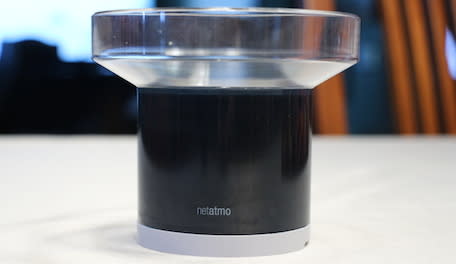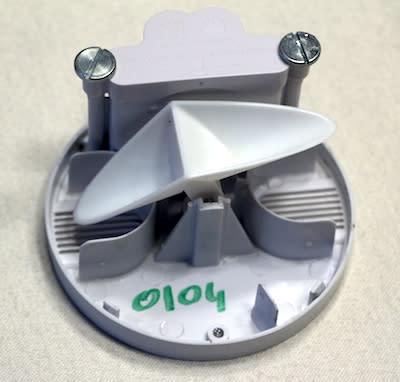Netatmo expands iOS-friendly Weather Station with Rain Gauge

Netatmo introduced its Weather Station (US$179) to the world in 2012, providing an easy way for iPhone owners to track indoor and outdoor temperatures and air quality at their homes or offices. Since that time, a vast number of users have enjoyed the ease of use of the free iOS app and the ability to see what's going on weather-wise not only in and around their own homes, but across the world through shared data. While I've used the Netatmo Weather Station for almost two years and have been impressed with how it just chugs along sending out data, I've regretted not having the ability to know how much precipitation has fallen at my home. The company has just released a new accessory for the Weather Station -- a $79 Rain Gauge that works with the base station to add precipitation measurement to the mix.
Specifications
Dimensions: Funnel diameter: 5.0 in (12.7 cm), base diameter 3.5 in (8.89 cm), height 4.5 in (11.43 cm)
Weight: 7.3 oz (206.95 gms)
Type of rain gauge: tipping bucket
Measuring range: .2 mm/hr to 900 mm/hr (.0078 inches/hr to 35.43 inches/hr)
Accuracy: 1 mm/hr (.0394 inches/hr)
Max. distance between base station and rain gauge: 100 m (328 feet)
Power: Two AAA batteries (included)
Design Highlights
Netatmo's Weather Station is very stylish, with the interior base station being a sleek aluminum cylinder that does all of its work without being obtrusive. Likewise, the Rain Gauge is very attractive and would not be out of place on a patio or veranda.
On the bottom of the Rain Gauge is a common tripod screw mount, which means that it can be placed atop a number of widely available mounting options. For my tests, I just put the device on the ground -- not the best location, but it was for a temporary test.
The actual rain gauge is located within the body of the device under the funnel area. It uses a very common type of gauge called a "tipping bucket" -- there is a seesaw-like mechanism with two tiny buckets, one on each side of a counter. When a bucket fills with rain, it tips and empties itself while the other fills up. The back and forth motion of the mechanism is counted, which provides a highly accurate measure of just how much rain has fallen.

Functionality Highlights
The Rain Gauge was quite easy to add to the Netatmo Weather Station network, even without instructions (this was a pre-release unit). The process simply required pressing the top of the base station until the seldom-seen LED on the front of the unit glowed blue, at which point it restarted and added the gauge.
Once the Rain Gauge was added to the system, it was just a matter of waiting for rain. Here in dry Colorado, I was concerned that I might have to wait weeks until I'd be able to send the unit back to Netatmo, but fortunately we received a nice downpour last night that started at about 6 PM and dumped rain on and off for about four hours.
I own and operate a "professional" weather station, so I was able to make a comparison of the readings I got from both stations. Sure enough, both stations showed the rain starting and ending at about the same time. Looking at the hourly precipitation totals in the Netatmo app showed .06 inches in the first hour, .12 inches in the second hour, .09 inches in the third hour, and .13 inches in the fourth hour for a total of .40 inches. My other station showed .09 inches in the first hour, .15 inches in the second hour, .12 inches in the third hour, and .13 inches in the fourth hour for a total of .49 inches.
Upon retrieving the Netatmo Rain Gauge this morning I found out why it didn't measure as much precipitation as the other station -- it was located near some trees that are currently budding out and the funnel had a lot of "tree debris" that was blocking it. For the most part, though, I felt that the Netatmo gauge worked well and accurately measured as much of the rain as it could.
Conclusion
The Rain Gauge is a welcome addition to the Netatmo Weather Station ecosystem and adds another data point to any personal weather records you may wish to keep. Especially in drier climates, knowing exactly how much precipitation you received at your location can help save water used in keeping lawns and gardens thriving, and you'll always have that information on your iPhone with the Netatmo app. While the Rain Gauge is more pricy than a standard manual rain gauge, just think of it this way -- you don't have to empty the Netatmo Rain Gauge once a day.
Rating: 4 stars out of 4 stars possible


